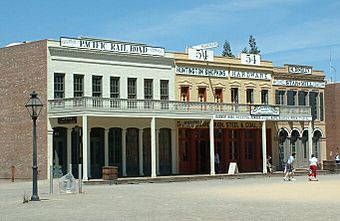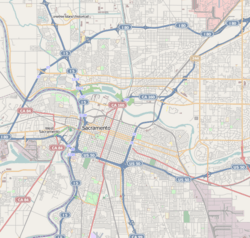Big Four House facts for kids
|
Big Four Building
|
|
|
U.S. National Historic Landmark District
Contributing Property |
|

The Big Four Building, Old Sacramento
|
|
| Location | 220–226 K Street, Sacramento, California |
|---|---|
| Built | c.1852 |
| Architectural style | Neo-Renaissance |
| NRHP reference No. | 14000782 |
Quick facts for kids Significant dates |
|
| Added to NRHP | October 15, 1966 |
| Designated NHL | July 4, 1961 |
The Big Four Building is a very old and important building in Downtown Sacramento, California. It was built a long time ago, in the 1850s. Today, you can find it in the Old Sacramento State Historic Park. This building is famous because it was where four important businessmen, known as "The Big Four," started their big railroad company.
Contents
A Look Back in Time
The Big Four Building wasn't always one big building. It started as three separate buildings. These were built between 1851 and 1852. They stood right next to the Sacramento River waterfront. The original three buildings were called the Stanford Building, the Huntington & Hopkins Building, and the Miller Building.
Who Were The Big Four?
The ground floors of these buildings were used by different merchants. Three of these merchants later became very famous. They were known as The Big Four. This is how the building got its name. The fourth member of this group was Charles Crocker.
The Big Four were:
These four men are famous for starting the First Transcontinental Railroad. This huge railroad project connected California with the Eastern U.S.
The Central Pacific Railroad
On the second floor of these buildings, The Big Four started their railroad company. It was called the Central Pacific Railroad Company of California. From 1862 to 1873, these offices were where they planned and managed the western part of the Transcontinental Railroad. They also founded the Southern Pacific Railroad here.
One of the businesses on the ground floor was Huntington, Hopkins & Co. This company sold hardware, iron, steel, and coal. It was located at 54 "K" Street.
Becoming One Building
By 1878, the ownership of the three separate buildings was combined. The buildings were then made into one larger structure. Over the years, this single building has been home to many different businesses. It has had shops, including the Huntington & Hopkins Hardware Store. It also housed a bar, a cafe, and a hotel on its second floor.
A National Treasure
The Big Four Building is considered a very important historical site. It was named a National Historic Landmark on July 4, 1961. This means it's a place recognized by the U.S. government for its special history.
The building is also part of the Old Sacramento Historic District. This entire district is also a National Historic Landmark. It is listed on the National Register of Historic Places. This register keeps track of important historical places across the country.
The Big Four Building was once a California Historical Landmark on its own. Now, it is included as an important part of the Old Sacramento National Historic District.





